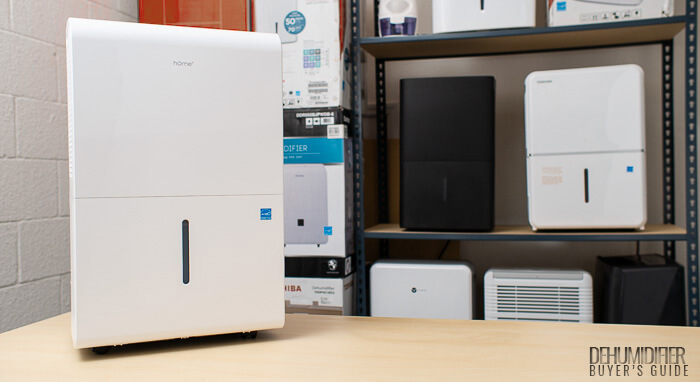
- A tremendous value – one of the least expensive 50 pint dehumidifiers we’ve tested thus far
- Comes with a great warranty – 2 years compared to only 1 year for most other dehumidifiers on the market
- Very portable for its size – one of the lightest 50 pint units we’ve tested
- Loud compressor
- Not the most well-built 50 pint dehumidifier we’ve tested – built using noticeably lower quality components than the #1 rated Frigidaire FFAD5033W1
- Dehumidifier
- Instruction Manual
| Energy Efficiency | 4.0 |
| Noise Output | 5.0 |
| Moisture Removal | 4.0 |
| Hygrometer Accuracy | 4.0 |
| Durability | 4.0 |
| Adjustability | 4.0 |
| Versatility | 4.5 |
| Extra Features | 4.5 |
| Ease of Use | 3.0 |
| Portability | 4.5 |
| Warranty | 5.0 |
| Value | 5.0 |
| Editor's Score | 4.5 |
Quick Review Summary
The hOmeLabs 4,500 sq. ft. Energy Star Dehumidifier (model no. HME020031N) is a terrific value in the 50 pint dehumidifier category. It’s staunchest competitor in this size class, the Frigidaire FFAD5033W1, is notably more expensive – it normally retails for about $50 more than the HME020031N.
Does the HME020031N’s lower price come at the cost of reduced performance and/or functionality? How does it compare, specifically, in all rated categories, to the Frigidaire FFAD5033W1? We answer both of these questions in detail in the review below.
Note that we wrote most of the review below when the Frigidaire FFAD5033W1 was our top pick, before we tested the Midea Cube. For this reason, we mostly compare the HME020031N to the FFAD5033W1 (not the Cube) in this review.
Also note that while this review is for the 4,500 sq. ft. (50 pint) HME020031N, much of it also applies to the 3,000 sq. ft. (35 pint) HME020006N and 1,500 sq. ft. (22 pint) HME020030N, especially sections on durability, adjustability, versatility, extra features, ease of use, warranty, and value as all hOmeLabs units feature very similar specifications (outside of moisture removal rate and power draw) and are built using very similar components with a very similar design.
2024 Update
It appears this unit no longer comes with a 2 year warranty. The manufacturer’s website now states that it only comes with a one year warranty, though you can still add an additional year (for a total of 2 years) if you register your purchase with the manufacturer.
Performance Test Results
Energy Efficiency
The manufacturer specifies the HME020031N as having a power draw of 6.5 amps. At 115V this translates to 748 watts.
The HME020031N’s rated power draw of 6.5 amps compares favorably to most other high capacity units on the market. The manufacturer specified power draw for the #1 recommended Frigidaire FFAD5033W1 is more – it’s 7.8 amps. It’s also more for the Black+Decker BDT50WTB – it’s rated at 7 amps of power draw. Many other models have a rated amperage over 7 amps.
All of this would seem to indicate that the hOmeLabs is one of the least power hungry dehumidifiers on the market. However, our own real world testing contradict these manufacturer specifications.
At 50% relative humidity we measured the hOmeLabs at 610 watts of power draw, the Frigidaire at 570 watts, and the Black+Decker at 554 watts. At higher humidity levels power draw increased and evened out around 760 watts for all three units.
But wait, there’s more!
Energy efficiency is a two headed snake: it involves power draw and moisture removal rate. For example, let’s say you have a standard appliance pulling 100 watts of power that takes 10 hours to do a job. Another appliance pulls 500 watts of power but only takes 1 hour to do exactly the same job. Which appliance draws more power? The first. Which appliance is more energy efficient? The second.
The same principle applies when evaluating a dehumidifier’s efficiency. The Frigidaire FFAD5033W1 draws slightly less power than the hOmeLabs unit at lower humidity levels (570 vs 610 watts) and approximately the same amount of power at higher humidity levels.
But here’s the added variable – according to our moisture removal tests, the Frigidaire removes moisture faster (removes the same amount of moisture in less time) than the hOmeLabs unit by a considerable margin (more on this later). With these facts in mind we feel confident calling the Frigidaire FFAD5033W1 the more energy efficient dehumidifier.
That being said, the hOmeLabs HME020031N also did very well in our moisture removal testing (just not as good as the Frigidaire) and for this reason we still consider it a highly energy efficient option compared to most competition in the high capacity size class.
Nonetheless, when it comes to energy efficiency –
Winner: Frigidaire
Extra note
You can use manufacturer specified amperage to evaluate how much of a standard 15 amp circuit is going to be “used up” by the dehumidifier. On any household circuit you don’t want more than 80% of the available amperage being used at any given time. Doing so could cause the associated circuit breaker to trip and/or cause an electrical fire.
As an example, let’s say you have a microwave, a fridge, and a toaster oven on the same 15 amp circuit. You then add a dehumidifier to the circuit. Adding up the amperages of each appliance you wouldn’t want the total power draw to exceed 15 * .8 = 12 amps. If you know the amperages of the microwave, fridge, and toaster oven you can add those right now and subtract that total from 12 amps. If the left over available amperage is less than 6.5 amps you cannot safely use the hOmeLabs 4,500 sq. ft. unit on the same circuit.
Noise Output
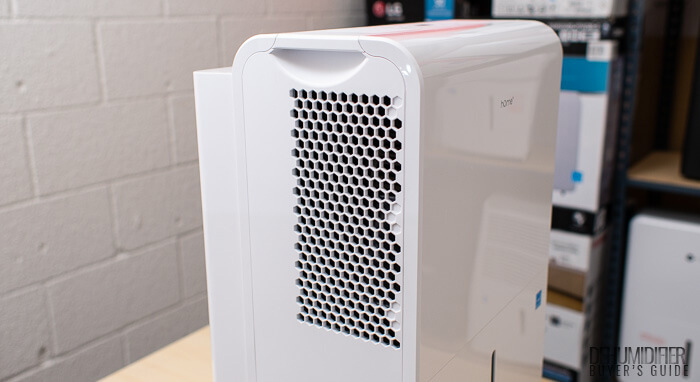
We test for noise output in two different tests. The first test involves placing the sound meter right above the dehumidifier’s control panel. The second test involves placing it 10 feet away from the dehumidifier. In each test we measure noise output on both low and high fan speed.
If you were to take recorded dB values at face value you would think that the hOmeLabs 4,500 sq. ft. dehumidifier performed very well in our noise output tests. At close distance (by the dehumidifier’s control panel) on high fan speed we recorded 59.3 dB on the sound meter. On low fan speed – 58.6 dB. At long range (10 ft.) we recorded 50.3 dB on high fan speed and 48.8 dB on low fan speed.
These readings were all well below average for the 50 pint size class. They are also much lower than readings recorded for the FFAD5033W1. For example, in the first test (control panel on high fan speed) the hOmeLabs produced 59.3 dB of noise while the FFAD7033R1 produced 70.2 dB of noise. In fact, in all four tests the hOmeLabs unit was measured to produce considerably less noise than the Frigidaire FFAD5033W1.
But, these statements come with major caveats:
First, the compressor buzzing noise produced by the hOmeLabs was much louder than the same noise produced by the Frigidaire.
Second, the Frigidaire has a much higher CFM fan (229 CFM on high fan speed vs 188 CFM on the hOmeLabs) and an upward facing exhaust that masked its compressor noise much better than the lower CFM fan and sideways facing exhaust of the hOmeLabs.
The easy comparison to draw here is to a fridge. Refrigerators, like dehumidifiers, use compressors. Have you ever heard an old fridge make a buzzing noise? That’s exactly the noise the hOmeLabs unit makes and, to a lesser extent, that the Frigidaire makes.
While the sound meter shows the hOmeLabs unit to produce less dB of noise, our hands on testing of both the HME020031N and FFAD5033W1 showed the Frigidaire to produce a much more pleasant sounding noise. With the Frigidaire, all you hear is fan noise. With the hOmeLabs unit, you still hear fan noise but you also hear a compressor buzzing noise that cuts through the fan noise.
In terms of raw noise output,
Winner: hOmeLabs
In terms of the quality of the noise that is produced,
Winner: Frigidaire
Moisture Removal
The hOmeLabs 4,500 sq. ft. dehumidifier performed quite well in our moisture removal tests. In our first test, in which we measure how long it takes the dehumidifier to dehumidify a 50 square foot room from 90% to 40% humidity its time of 10 minutes, 3 seconds puts it in the upper (faster) half of performers in the 50 pint category. The same is true for its performance in the second test, in which we measure how long it takes the unit to dehumidify the same space from 80% down to 50% relative humidity. In this test, it was measured to do so in 5 minutes, 33 seconds.
In the first more difficult test (90% to 40%), the hOmeLabs HME020031N took about 2 minutes longer than the FFAD5033W1 (7 minutes, 56 seconds). In the second test (80% to 50%) it took only a few seconds longer than the Frigidaire (5 minutes, 19 seconds).
Thus, according to our testing, you can expect the Frigidaire to do much better than the hOmeLabs in especially challenging (highly humid) conditions. In reasonably non-challenging conditions (mild to low humidity) both units should perform quite similarly.
In conclusion,
Winner: Frigidaire
Hygrometer Accuracy
The HME020031N’s built-in hygrometer was tested to read room humidity to within 2 to 3% of the actual room humidity. For example, at 54% RH it would show a reading of 51 to 52% RH. We saw very similar performance when testing the FFAD5033W1.
Winner: Tie
Included Features, Functionality, Build Quality, Warranties, and Value
Durability (Build Quality)
General Impressions
The HME020031N is a budget grade dehumidifier. At a glance it looks very similar to a higher end unit like the Frigidaire FFAD5033W1 but upon closer inspection it becomes quite clear which unit is better built with higher end components.
The hOmeLabs unit has three problem areas, in particular:
1. Its water tank (see photo below) which in itself has two problem areas: the edges of the tank and the piece that connects the handle to the tank. The edges of the tank are made of an especially thin piece of plastic. We believe these edges can bend, crack, or even break over continual use (when emptying and replacing the water tank). We would also like to see the handle connected to the tank in a more secure manner. The water tank can get quite heavy when filled with water. We believe it’s quite possible for the handle to break off from the tank over continual use as it is currently constructed and attached to the tank.
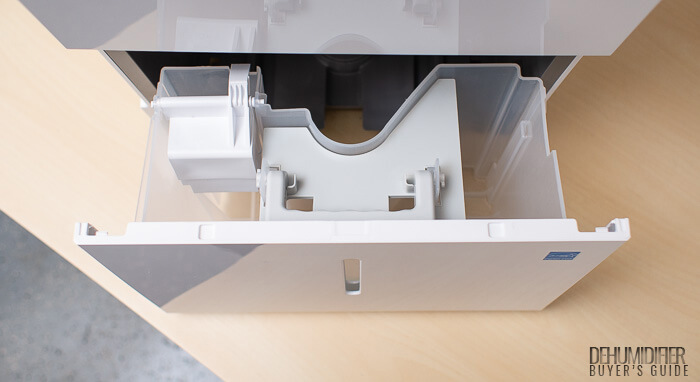
2. The unit’s air filter (see photo below) is glued to an especially thin plastic frame. We believe this frame may be susceptible to cracking and/or breaking over continued use. We also don’t like the fact that the filter is permanently glued to the grille. For comparison, the Frigidaire FFAD5033W1’s filter is a separate part that can be removed from its grille for cleaning.
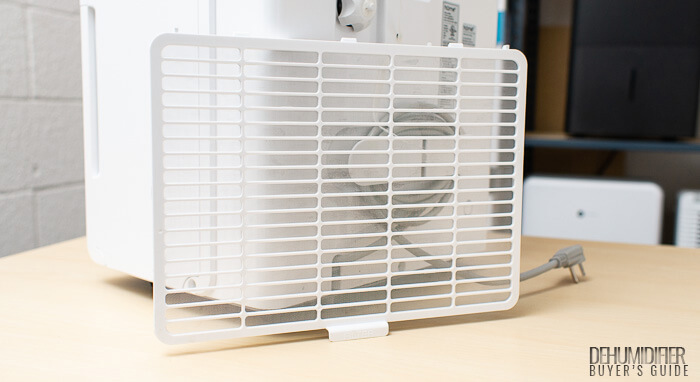
3. The unit’s control panel appears to be composed of especially low quality parts. The LED display is of a noticeably lower quality than that of many other dehumidifiers we’ve tested.
Consumer Feedback
The HME020031N has thus far seen an overwhelmingly positive response from consumers. The vast majority of user reviews praise its great value (something we agree with), quiet operation (something we do not necessarily agree with), and effectiveness in lowering humidity in a timely manner (something we mostly agree with). According to our most recent survey it has a negative review rate (% of total reviews that are 1 and 2 star reviews) of only about 6%.
There is one important caveat here: in evaluating consumer response to this dehumidifier you have to consider the fact that most consumers only purchase one dehumidifier at a time. We’ve tested twenty-six high capacity units alone. Comparing them side by side makes it very clear which dehumidifier is better than the other in which areas. Most consumers don’t have the ability to base their rating off of a comparison of multiple units.
On the flip side of things consumers definitely use these units over a longer period of time than we do. And so consumer feedback, while not the best indicator of overall performance and build quality compared to the competition, is a good indicator of long term reliability.
Overall Category Score
According to our own hands-on testing, the hOmeLabs dehumidifier has a few problem areas when it comes to long term durability and reliability, but it is by no means a poorly built dehumidifier. Furthermore, consumer feedback indicates good reliability with this unit. We rate its durability as being below that of top tier units like the FFAD5033W1 only because the difference in build quality is so stark. Nonetheless, it still receives an above average score in the category: a 4/5.
Adjustability
The hOmeLabs HME020031N features standard adjustability for the size class: a humidistat that can be adjusted in 5% increments and a timer that can be set up to 24 hours. You can set the timer when the dehumidifier is off for an auto-start or set it when the dehumidifier is on for an auto-off up to 24 hours.
This hOmeLabs unit features two fan speed – normal and turbo – as opposed to 3 fan speeds for the Frigidaire FFAD5033W1. Both units feature a continuous mode that simply runs the dehumidifier at maximum power continuously.
Overall Category Score
We don’t have much to say in this category. The hOmeLabs unit, for the most part, features standard functionality here. It does have one less fan speed than the most adjustable units we’ve tested which reduces its score in the category to 4/5.
Versatility
Set Humidity Range
This dehumidifier can be set to a desired humidity level between 35% and 85%. For example, should you set it to 40% and the actual room humidity is 60%, the dehumidifier will run until the room reaches 40% humidity. We have tested 50 pint units that can be set to as low as 30% or as high as 90% but a range of 35% to 85% is perfectly acceptable for the vast majority of applications.
Operating Temperature Range
The manufacturer specifies a minimum operating temp. of 41° F. We couldn’t find any reference (in the user manual or online literature) to a maximum temperature although almost every other compressor based unit we tested is limited to a maximum temperature of 89° to 90° F.
Gravity Drainage
The unit can be drained using a standard garden hose connected to the back of the dehumidifier (photo below shows the drain plug location). Doing so will prevent condensate from collecting in the water tank.
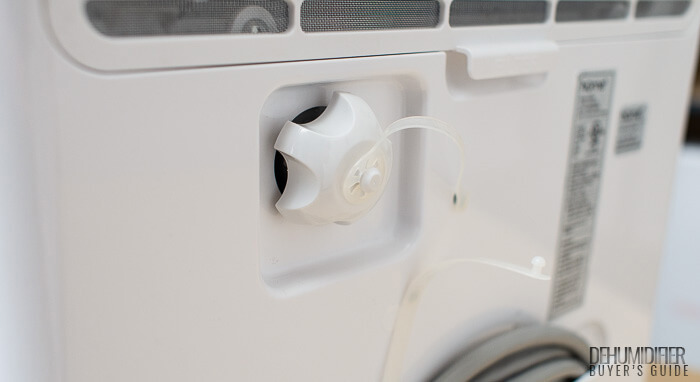
Built-in Pump
This unit does not feature a built-in pump.
Overall Category Score
Again, this hOmeLabs 4,500 sq. ft. dehumidifier features standard functionality in the category. It has a nearly identical humidity range, operating temperature range, and drainage functionality to that of the FFAD5033W1. It earns an identical score in the category – a 4.5/5.
Extra Features
Temperature Reading
This unit does not display room temperature. Neither does the FFAD5033W1 or most other compressor based dehumidifiers on the market.
Defrost
This unit features an auto-defrost mode. This mode will activate automatically at lower temperatures. The hOmeLabs also features an indicator light on its control panel to let you know when the mode is activated.
The FFAD5033W1 does not feature a dedicated defrost mode as it does not need it. The unit is optimized for low temperature operation without needing to employ a separate defrost mode.
Check Filter
A check filter light will illuminate on the unit’s control panel after several hundred hours of use. This light doesn’t work in conjunction with any sensors. It’s simply a pre-programmed reminder light.
Overall Category Score
The hOmeLabs unit earns a 4.5/5 in the category.
Ease of Use
LED Display Clarity
The hOmeLabs dehumidifier’s control panel looks and feels very similar to that of most other units on the market. Unfortunately, this means that it is not as good as the FFAD5033W1’s control panel. While the FFAD5033W1 has a very sleekly designed control panel with a higher quality LED display, the hOmeLabs unit has a more primitively styled control panel with a lower quality LED display.
Setup Difficulty
Both Frigidaire and hOmeLabs units are very easy to setup and program.
Filter Removal Difficulty
The hOmeLabs’ air filter is permanently glued to its grille. You simply remove its grille to clean its filter. With the Frigidaire you still remove its grille to access its filter, but the filter is a separate part that you unclip from the grille before cleaning it.
Manual Clarity
All hOmeLabs dehumidifiers have the same well written, well organized, and well-illustrated manual.
Water Tank Size
Both the hOmeLabs 4,500 sq. ft. (50 pint) and 3,500 sq. ft. (35 pint) units have the same capacity water tank – 1.6 gallons or 12.8 pints. The Frigidaire FFAD5033W1has a much larger 16.9 pint water tank.
Also of note is the fact that the FFAD5033W1’s tank features a plastic piece that extends over most of the top of the tank. This plastic piece is there to prevent water from splashing out of the tank every time you remove the tank to empty and replace it. The hOmeLabs unit’s water tank does not offer this same functionality.
Overall Category Score
Compared to the Frigidaire FFAD5033W1, the hOmeLabs HME020031N features a lower quality LED display, a much smaller water tank, and one without splash guard functionality. Unsurprisingly, it earns a lower score in the category – a 3/5.
Aesthetics
At a glance, all hOmeLabs dehumidifiers are very pleasing to look at. Should you purchase and receive this dehumidifier, it’s highly unlikely you’ll be complaining about the way it looks – it really does look great – exactly like a modern appliance should.
Portability
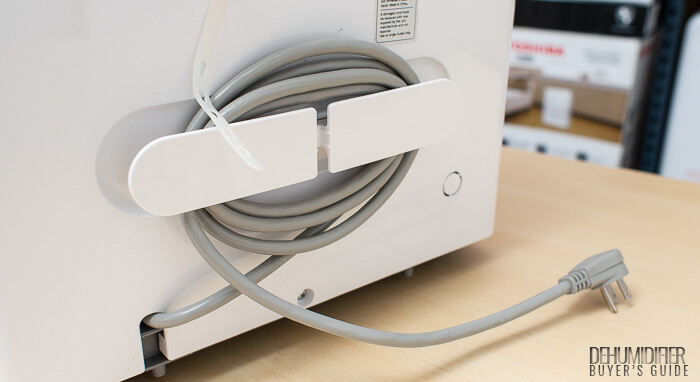
The hOmeLabs 4,500 sq. ft. dehumidifier weighs only 40 lb. – about 3 lb. lighter than the Frigidaire FFAD5033W1.
Like the Frigidaire it features excellent cord storage (see photo above). Unlike the Frigidaire, this hOmeLabs unit features side pocket handles. The FFAD5033W1 features a handle that extends from the top of the dehumidifier. Both units have similar dimensions: approximately 15 in. wide, 12 in. deep, and 24 in. tall.
Overall Category Score
The HME020031N scores very well in this category. The primary reason why is its weight. At only 40 lb. it is very light for a 50 pint dehumidifier. Its side pocket handles work well and its cord storage is excellent. It earns a 4.5/5 in the category.
Warranty (Manufacturer’s)
This hOmeLabs dehumidifier comes with a 1 year warranty on all parts. If you register your dehumidifier on the manufacturer’s website another year can be added to the warranty.
Most other 50 pint dehumidifiers on the market, including the Frigidaire FFAD5033W1, come with only a 1 year warranty
The only caveat is this: We’re sure that hOmeLabs is a terrific company but they’re relatively unknown and haven’t been around for a very long time. Even if you register your purchase to get a full 2 year warranty, who’s to say that the manufacturer will even be there to honor the warranty a few years from now? With companies that have been around for several decades – companies like Danby, Frigidaire, Honeywell, etc. – it’s more likely for them to still be there if and/or when it comes time to honor that warranty.
Nonetheless, we still think the hOmeLabs is the better pick if warranty length is a priority for you.
Value
All hOmeLabs dehumidifiers are a terrific value. The 4,500 sq. ft. model retails for about $50 less than the Frigidaire as of the writing of this review.
Final Thoughts
The hOmeLabs HME020031N is one of the better performing 50 pint dehumidifiers we’ve tested. While it fails to outperform the exceptional Frigidaire FFAD5033W1 in most major categories it does perform better than most other 50 pint dehumidifiers we’ve tested.
The question then, is which dehumidifier is the better buying choice? The hOmeLabs or the Frigidaire?
Here’s the short answer: the Frigidaire FFAD5033W1.
Here’s the longer answer: The Frigidaire is more energy efficient (because it removes moisture faster). We also consider it to be more “quiet” simply because it doesn’t make the same audible compressor buzzing noise the hOmeLabs makes. In our opinion, the Frigidaire is also the better built, more high quality dehumidifier of the two units. This is painstakingly obvious when placing the two units side by side.
On the flip side of things the hOmeLabs unit is likely to be cheaper. It usually retails for about $50 less than the Frigidaire. It also comes with a longer warranty – 2 years vs 1 year for the Frigidaire. In all other categories, the two units perform very similarly.
So, in summary, the Frigidaire either ties or outperforms the hOmeLabs in almost every category except value and warranty. Is the approx. $50 price difference enough of a difference for us to recommend the hOmeLabs over the Frigidaire? No it is not. We believe that the extra energy efficiency, faster moisture removal rate, more pleasant sounding noise output, and better overall build quality of the FFAD5033W1 is more than enough reason to recommend it over the hOmeLabs unit, even though it is the more expensive option.
That being said, if you’re on a tight budget and cannot spare the extra (approx.) $50, or if you would feel much better about your purchase with a longer included warranty, the hOmeLabs HME020031N is still a great option. It will dehumidify fairly quickly and it will do so fairly quietly (albeit with a compressor buzzing noise). It has an identical set humidity range and operating temperature range.
If you were to never purchase the FFAD5033W1 and compare it side by side with the hOmeLabs unit you will almost certainly be very happy with your purchase of the hOmeLabs unit.
Which is the better dehumidifier? The Frigidaire. Which is the better dehumidifier if you only have (approx.) $220 to spend or simply don’t want to spend more than (approx.) $220 on a dehumidifier? The hOmeLabs.
Have a question or comment? Let us know below.
Does the Frigidaire have a drain hose?
One of the worst home appliance purchases I’ve made. Lasted just over 2 years which is outside of the warranty. Company offered no help or support. Would never buy another one of the Home products. Better off getting a cheap dehumidifier from Lowe’s or Home Depot.
I just bought a new Homelabs dehumidifier. It’s been running for over 24 hours and hasn’t collected any water. Any suggestions?
Hopefully he can get some help if it’s within the warranty. Had no luck with mine.
I bought a Homelabs dehumidifier from Amazon and it quit working after approximately 10 months. I called Homelabs and they sent me a new one no problem. It quit working after 6 months and I couldn’t get help from them.
An update to my prior post. Homelab has said that a second year can be added to the basic one year warranty year during product registration.
I’ve also added this information to the review.
The Homelab review highlights a 2 year warranty but the company website states only one year. Please check
Thank you for letting me know. I’ve added this updated information to the review.
Where is the Homelabs dehumidifier manufactured, built, assembled etc. I have purchased two 50 pint units from a highly recommended dehumidifier but both units power cuts off after about 6 hours of continuous operation. Removing the power plug then replacing it and the unit restarts. No help from the factory. Sent it back for refund. What could cause this and is the Homelabs unit going to do the same/ it is a QC issue I think. All I expect is a reliable dehumidifier but have not found it yet. Please advise
Hi,
I’m puzzled. I just had my dehum stop working in June (June 24). So I contacted homeLabs. I was told that the warranty period is 1 Year. Then they tell me that the warranty period is 2 years if you register the unit online the warrant period is then 2 years. Please advise. Is the base warranty period 1 year or 2 years? Based on your review, above, you state the warranty period is 2 years. Pease advise.
Curious to see which is more efficient in the 22-pint class.
I have the 4500 Sq. Ft. Homeland dehumidifier! What causes it to ice over on the back of the unit ?
I would be interested in the RECALLS of HomeLab & Frigidaire Dehumidifers (for example HomeLabs HME020031N vs Frigidaire FFAD5033W1 & others ) regarding pretty much all aspects but more specifically Electrically-electric Fires, electric burns, electrical overheating, smoke inhalation , chemical inhalation from burning wires or plastic casing or anything else you feel is important. I am an elderly man of 70 years in an retirement bldg. and I don’t want to harm the other residents with a fire or smoke.
Why does my HOMEHMF020031 not drain with a hose? I’ve hooked a hose up to it but we continually have to empty the bucket?
I have close to a 1000 sq foot basement. I’m learning towards purchasing the Frigidaire dehumidifier brand based on your very informative comparison report!
Based on the sq footage of my basement
could you please advise me what you feel would be the ideal moisture removal efficiency/capacity of the dehumidifier I
should consider purchasing. Is it a proven fact that a larger capacity unit will remove moisture at a faster rate than a smaller capacity unit and in the long run prove to be more efficient in terms of electrical usage?
I will look forward to hearing your recommendation and really appreciate reading your very well done comparison report on the Home/Frigidaire dehumidifiers!
Thank you,
Peter
I would recommend the Frigidaire FFAD5033W1 for your application. I talk about dehumidifier sizing in general in this guide.
Just as an FYI I have had a Frigidaire 30 pint for at least 15 years. Still runs like a champ. Just heavy to carry from basement to second floor of house.
I’m on my 3rd hOmeLabs humidifier in 2 years… the two previous ones would ice up. Each would work well initially. The 2nd season is when the problems began. The automatic defrost didn’t activate causing reduced dehumidifying function. I had to manually check the unit several times a day to keep it operating. The company was good in replacing the units, but my warranty will expire this year and I fear it will happen again on this replacement unit next season.
I’ve had the same thing happen. Not cool (literally). I too had to send one back already and had one returned. I’m monitoring the power usage (via a Kill-0-Watt meter inline with the plug) to find that the fan was blowing, but not the compressor.
Anyway, I reached out to HomeLabs customer service but no response yet.
I’m not sure why Consumer Reports puts Homelabs as high reliability.
Same thing happened to me.
The 50pint hOmeLabs unit now cost more than the 50pint Frigidare! Very little reason to get the hOmeLabs unit now.
BTW great reviews. I picked up the Frigidare and it works great for my basement.
Here I go again, I bought the Frigidaire FFAD5033W1 but it froze up on day one, after removing 5% of humidity in a few hours and was so happy with until frost build up. So took back. You mention the hOmeLabs HME020031n as the best defrost unit but all the customer reviews I have read show it does frost up a lot. Want to try the Honeywell TP70WKN but it is heavy and I had trouble getting the Frigidaire up basement stairs ( I am 75). Not sure which I should try as the Honeywell seems to have less issues. How do I find your responses? Could you e-mail it to me? So much on your website to try and find. Thanks I bought the Honeywell and it is sitting by basement door and don’t want to try and get down stairs until I hear from you. Please respond
Great reviews, but I have to locations – one is hands down in the size range of the Frigidaire. The other is a 200 sq ft insulated room in an out-building and the 50 pinters seem a bit large. I understand your “go big” philosophy for most situations, but does it hold true down to this size? If not, recommendation? Thx.
For such a small space (200 square ft.) you can definitely get away with a smaller 35 pint or even 22 pint unit like this one.
I think the humidifier is contributing to a musty smell in my basement. What can I do about it?
How do I register my homelabs dehumidifier?
What causes the unit to continually frosting over. The filter has been cleaned weekly.
The unit should automatically defrost its coils over time. If it doesn’t, it usually means the temperature is too low (below 41 °F) for normal operation.